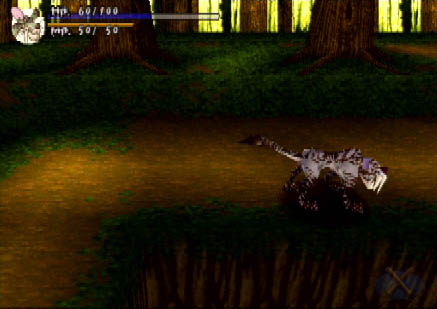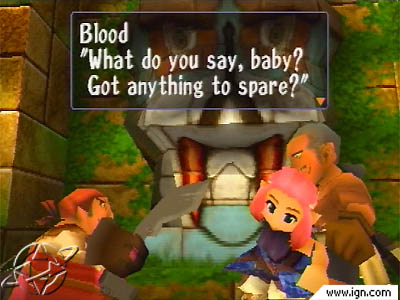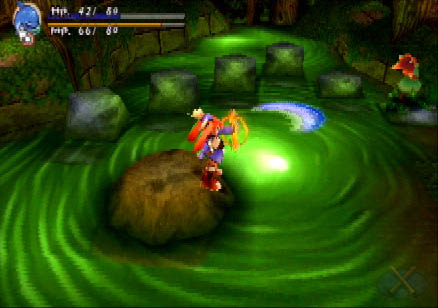 |
Threads of Fate- Review |
 |
[(Relic)] Hunter
By: Andrew Long
| Review Breakdown |
| Battle System |
7 |
| Interface |
5 |
| Music/Sound |
8 |
| Originality |
7 |
| Plot |
2 |
| Localization |
3 |
| Replay Value |
8 |
| Visuals |
7 |
| Difficulty |
Moderately Easy |
| Time to Complete |
7-15 hours(per 'story')
|
|
| Overall |
 |
| Criteria
|
From the outset, the [(relic)] is central to Threads
of fate. This [(relic)] is described in a number of terms, varying over
the course of the game, but it's quite clear it's going to be central
to everything. The question is, can a game based around such a flimsy
concept work? After all, one of the characters wants it to resurrect his
dead girlfriend, and the other wants it for "World Domination, Baby!"
Neither of these motivations is particularly inventive, and yet Threads
of Fate does manage to pull a few strings in the right places.
Threads of Fate is immediately endearing in a kiddy
sort of way. The graphics are bright, the character models just this side
of cute, and the dialogue simplistic enough for younger gamers to follow.
Despite this apparent lack of complexity, the level of fun inherent in
the simple act of playing the game is more than enough to compensate. Rue and Mint are
the two main characters, and each has their own talent in battle. Rue,
in addition to his unidentifiable bladed weapon, also possesses the ability
to transform into the various monsters he defeats. He is able to retain
the last five monster types he has defeated, and in their forms can execute
a variety of attacks. Some are useful, some are simply kind of funny looking.
There is also a fair bit of duplication, but that is to be expected; there
are dozens of different types of monsters in the game's various areas,
so after awhile, it's only natural that 'kick' or 'double jump' gets repeated.
Mint, on the other hand, has rings for her weapons and casts magic she
learns at various points throughout the game. The magic is aimed automatically,
much like her attacks, so after awhile, the combat sequences settle down
to a steady rhythm of jumping, slashing, and the occasional spell to keep
things interesting. It's much the same with Rue; although transforming
into the monsters may be diverting at first, and is necessary at various
points in order to complete certain puzzles, it's by and large much easier
to retain his human form, as the attacks tend to be equally as powerful
or moreso than those he can execute as a monster. Thus, while there is a great potential for variety, in practice, it's not really much of a factor in the game.
This lack of variety also evidences itself in the game's exploration. While there are a number of dungeons to explore, there is nothing that can't be found in any other game, and additionally, the lack of a world map to explore is a bit of a letdown. While it is nice not to have to troop through earlier areas in order to reach later ones, it seems like something is somehow lacking. Corona, the game's one and only town, becomes central to the game as a result of the lack of a world map. Not only is it virtually the only place to save, it is home to a number of important shops and the requisite inn. The shops(including the church, which solicits donations in exchange for coins, which effectively amount to continues) are where armor, weapons, and attribute-enhancing potions can be purchased. Rue and Mint gain money by exchanging monster coins in the weapon shop; each monster killed is good for a coin. The only other way to make money is to best Rod, a swordsman, in combat. This rather spartan assortment of options is reflected in the game's interface, which is probably what they had in mind when they coined the word 'minimalistic'. The only things here are the bare essentials, and while this does help keep the game accessible to all ages, it detracts from its depth.

|
| Rue reflects on being sabre-toothed |
|
The town is also home to almost all of the game's characters, and thus, it
is where the plot is essentially played out. The storyline is functional-
if barely- and relies heavily on a 'go here, pick this up, go there, do
that' basis. In exchange for completing the various tasks, during which
various small plot points may also occur, the story advances a little
in town as well. In effect, it's as though you're a lab rat; complete
the maze, get a pellet, go back, do it again. It gets rather repetitive,
and results in much of the storyline being utterly forgettable. The part
of the story that does remain memorable is functional enough; it's just
nothing that hasn't been seen before, and the wealth of one-dimensional characters that change their minds(and allegiances) upon a whim don't help to prop it up.

|
| Elena wonders why Blood calls his friend "Babe"
|
|
One standout element of Threads of Fate is its rather
unique sound. Junya Nakano, the game's 'music compose', has opted for
a somewhat electronic approach. There are the usual video game elements,
but the ubiquitous drum riffs that show up in nearly every song give it
a unique feel as compared with other games. While this does represent
a sort of indigenous style, it also makes much of the music sound the
same. Even so, it is an original approach, and the music is generally
well-suited to the feel of the game. It is also complimented by some decent
sound effects; the metallic clang of Rue's weapon in particular is a very
satisfying sound.
In addition to having a distinctive sound, Threads of Fate also has a fairly distinctive look. The weapons, spells, and monsters in the game are all quite unique, and the environments, while they are admittedly quite standard(fire, ice, forest, and cave, along with a few other RPG staples all put in an appearance here) they do possess a unique look. Spell effects are suitably colourful, and the 3-D graphics stack up fairly well with similar titles. The game does feel rather similar to other action-RPGs, however, and one can't help but be reminded to a degree of games from the Seiken Densetsu series, as well as Brave Fencer Musashi. Still, there is enough that is new here to make the game worthwhile.
Worthwhile or not, it's still very puzzling that the
name of the [(relic)] was substituted with- well, [(relic)]. It's this,
along with a score of small errors in other places, that drag this translation
down. Little things like 'music compose' instead of 'music composer'(a
mistake repeated with sound composition) poor punctuation, and small spelling
errors leave it feeling like a bit of a rushed translation, an impression
that is not aided by the very childish dialogue. Then again, the game
was rushed to North America in an effort to fulfill Square's Summer of
Adventure timeline, so perhaps a rushed effort is understandable. This
does not, however, make it excusable.

|
| Mint takes up toxic gardening |
|
As an action-RPG, Threads of Fate has the advantage of being eminently replayable. Not only is it loads of fun to hop around braining things as Rue, Mint's magic is satisfying to attack with, and the game's environments, while generic, are a lot of fun to play through. While nobody will go through this game again to experience the storyline, the fact that there are two separate stories that can be played through(one as each character) combined with a few sidequests to keep things interesting, along with fiendishly cutesy (and difficult) minigames ensure this game won't collect dust after it gets finished.
The only total downside to Threads of Fate is how utterly easy it is.
Not only does the game take very little time to complete(15 hours represents
a very, very slow player), but dying is no real threat, since the option
to continue at the start of the level is presented in a virtually unlimited
quantity. The puzzles are usually not too difficult at all, and most bosses
can be dispatched with a minimum of trouble. Even so, the mini-games can
be annoyingly difficult, if only as a result of the digital gymnastics
they require.
Threads of Fate, as a result of these elements, is thus pretty light
fare for most gamers. As a result of its apparently young target audience,
a number of elements that could have been more complex are sacrificed
in favour of simplicity. Even so, it does manage to retain that most critical
element of fun, which makes it well worth playing.
|










